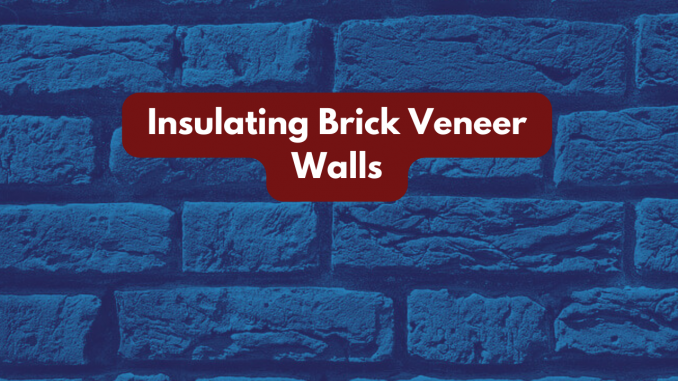
Brick veneer walls are a type of wall construction where a layer of bricks is used as a decorative facing or cladding over a structural frame or backing wall. Insulating brick veneer walls can help improve energy efficiency and comfort within a building.
Unlike traditional solid brick walls, where the bricks provide both structural support and the exterior finish, brick veneer walls rely on a separate structural support system, such as wood or steel framing, concrete block, or reinforced concrete, behind the brick facing.
The brick veneer is typically anchored to the backing wall using metal ties or other fasteners, providing stability and support. The space between the brick veneer and the backing wall is often filled with insulation to improve energy efficiency and provide additional protection against moisture and temperature fluctuations.
Why Should You Insulate Brick Veneer Walls?
Energy Efficiency
Insulating brick veneer walls helps regulate the temperature inside the building by reducing heat transfer through the walls. This can lead to lower heating and cooling costs, as the insulation helps maintain a more stable indoor temperature.
Improved Comfort
Insulation creates a more comfortable indoor environment by reducing drafts and minimizing temperature variations within the building. This can lead to increased occupant comfort and satisfaction.
Moisture Control
Insulation helps manage moisture levels within the wall assembly, reducing the risk of condensation and mold growth. Properly installed insulation, along with a moisture barrier, can help protect the building from water intrusion and associated damage.
Noise Reduction
Insulation dampens sound transmission through the walls, providing a quieter indoor environment by absorbing and blocking sound vibrations.
Long-Term Durability
Insulation protects the structural components of the building by reducing temperature fluctuations and minimizing the effects of thermal expansion and contraction on materials like wood framing and drywall.
Regulatory Compliance
Many building codes and energy efficiency standards require adequate insulation in exterior walls to meet minimum performance requirements. Insulating brick veneer walls ensures compliance with these regulations and may also qualify for energy efficiency incentives or certifications.
Insulating brick veneer walls contributes to a more energy-efficient, comfortable, and durable building envelope, benefiting both occupants and the long-term performance of the structure.
How to Insulate Brick Veneer Walls
Assess the Existing Conditions
Before insulating, assess the condition of the wall, checking for any damage or moisture issues that need to be addressed.
Choose the Insulation Material
Select an appropriate insulation material based on factors like R-value requirements, moisture resistance, and cost. Options include fiberglass batts, foam board insulation, spray foam insulation, and mineral wool.
Prepare the Surface
Clean the brick surface to remove any dirt, dust, or loose mortar. Repair any damaged areas or cracks in the brick veneer.
Install a Moisture Barrier
To protect against moisture infiltration, install a moisture barrier such as building paper or house wrap over the sheathing before adding insulation.
Install Insulation
Follow the manufacturer’s instructions to install the chosen insulation material. It’s a bit different from insulating a brick wall.
- Fiberglass batts: Fit batts between the studs without compressing the insulation.
- Foam board insulation: Cut boards to fit between the studs and secure them using adhesive or fasteners.
- Spray foam insulation: Apply spray foam directly onto the brick surface to fill cavities and gaps.
- Mineral wool: Fit batts between studs similar to fiberglass batts.
Seal Gaps and Cracks
Inspect the insulation for gaps or cracks and seal them with caulk or foam sealant to prevent air leakage.
Install Interior Finishes
Finish the interior wall with drywall or other materials once the insulation is installed and sealed.
Monitor for Moisture
Regularly inspect the wall for signs of moisture build up or issues, especially in humid or rainy climates. Vigilance helps ensure the insulation’s effectiveness and prevents moisture problems.
Spalling bricks can occur in brick veneer walls and may need repairing, particularly if the bricks are exposed to moisture and freeze-thaw cycles. Spalling refers to the process where the surface of a brick flakes or chips away, leading to deterioration of the brick over time. Several factors can contribute to spalling in brick veneer walls:

Leave a Reply